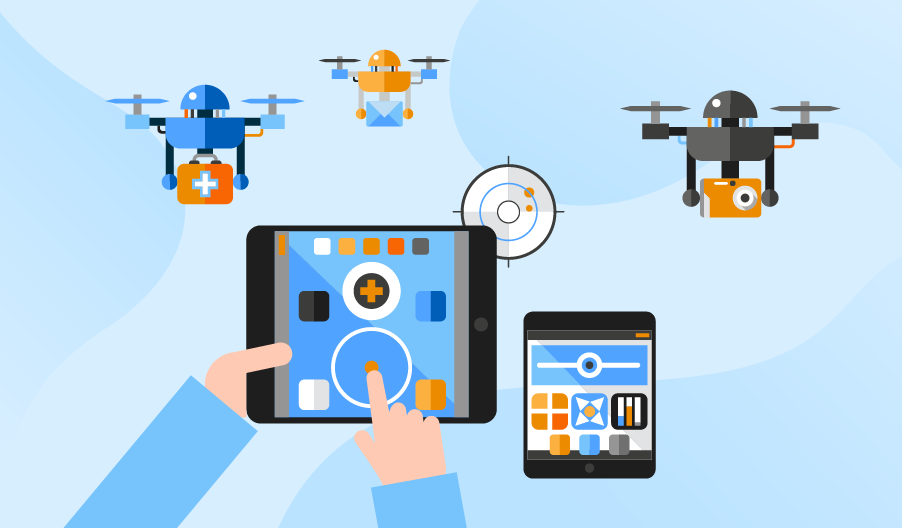Solar Power and Unmanned Aerial Vehicles
In recent years, government sectors and Defence personnel have faced difficulties in handling people during natural disasters or the period of dangerous situations. It might be the cause of incidents such as earthquakes, heavy floods, forest fires, or border surveillance monitoring between the countries, etc.,. In the field of Engineering, the new development of technologies is trending in all areas particularly to safeguard the life of people though the loss of human death was unable to be stopped or protected during such threatening conditions.
The contribution of aviation industries in such scenarios is booming to help society by monitoring and rescuing people at terrible incidents. The recent scenario of the aviation market states that the Defence sectors using pilot-less or Unmanned Aerial Vehicles for surveillance and reconnaissance applications are much more progressive in supporting the patrols.
Unmanned Aerial Vehicles and Solar Energy
Keeping the endurance limit of such Autonomous or Unmanned vehicles for a longer time is not an easy task during the operation. Though high-performance batteries are installed in the vehicles, the durability or the discharging levels would gradually go down concerning the power consumption of electronic components of unmanned aerial vehicles. To increase the storage capacity of batteries, naturally available solar energy has been utilized in such pilot-less autonomous vehicles for the betterment of Endurance.
So-called solar-powered unmanned vehicles have been developed in recent days with long endurance and range and are trending in the aviation market which attracts the defense sectors. Once the batteries are charged at the sunny time, unmanned aerial vehicles have the advantage of using the charged power during night hours so that this vehicle can be operated in both day and night hours.
The energy source which can be rechargeable batteries in the combinations of Nickel, Lithium–ion, and lead acid-based chemical compositions. Later in the years, unmanned aerial vehicles were designed to use natural sources of sunlight to generate power to fly for very long durations. In the year the 1980s, the new attention was propelled to use solar power for accelerating drone dynamics. Scientists and Designers worked to produce efficient solar photovoltaic cells that are connected to batteries. In the middle of the year 1970s, DuPont Corporation along with AeroVironment manufacturer attempted to make a solar energy-based autonomous vehicle mainly for the operations to be offered between European countries.
The Unmanned Aerial Vehicle named Gossamer Penguin was developed as a manned solar-powered experimental aircraft designed by Paul MacCready in association with AeroVironment manufacturing unit. The Penguin was designed with 21.64 meters of wingspan with an overall weight of 31 kg and it was demonstrated to the public during the year 1980.
There were electrical motors integrated into it and operated using 540 watts of solar panels with 3900 solar cells. The flight test was carried out at NASA`s Dryden Flight Research Centre exactly on 7th August 1980.
Helios Solar Powered Unmanned Aerial Vehicle
The Helios HP01 was modified with several updates, including the modernized avionics panels, higher altitude control systems, and sun power solar array integrated with nearly 62000 solar cells on the upper wing surface. Unfortunately, in the year 2006 Helios Prototype severely damaged in the entire wing section and was fell into the Pacific Ocean due to the massive turbulence. Almost the Helios wing went as a curved section very high dihedral angle. However, the investigations reported that the Helios was loaded with a high concentration of weight that was distributed on the entire wingspan structure significantly reducing the design effectiveness and the margin of safety.
In the modern aviation scenario, the utilization of solar energy was found to be the alternate source for unpiloted unnamed aerial vehicles. Since numerous designs are being developed, solar-powered Unmanned Aerial Vehicles could support long-endurance operations to satisfy future aviation challenges. Efficient design and powering the Unmanned Aerial Vehicles with solar energy possibly increases the flight time through which rescue operations during disaster seasons could be performed better at remote locations. Hence, the involvement of aviation in public health could be improved using modernized solar-powered Unmanned Aerial Vehicles.
Source

